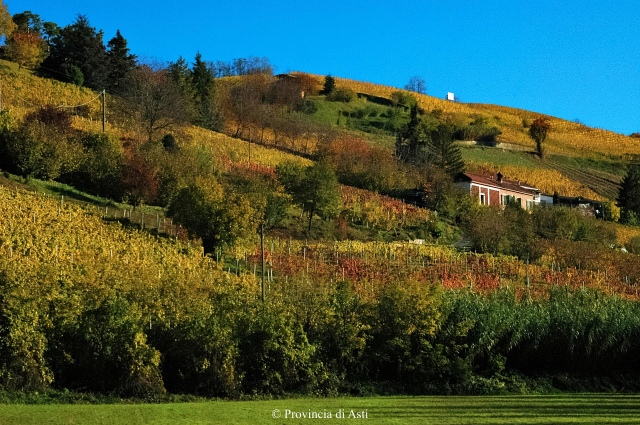Calamandrana
Last update 30 January 2024
Calamandrana: between the painted hills of Barbera and Muscat, the fortress that dominates the Belbo Valley
Landscape
Calamandrana is a town developed in two areas: Calamandrana Alta and Calamandrana Bassa.
It is about 35 km from the provincial capital, Asti.
Insights
“Il Paese”. Comune di Calamandrana, Apr. 18, 2018, www.comune.calamandrana.at.it/it/page/il-paese-29351308-e4f7-4b1c-bf60-0d5181c7f278. Last accessed Jan. 7, 2024.
“I sentieri naturalistici”. Comune di Calamandrana, Apr. 18, 2018, www.comune.calamandrana.at.it/it/page/i-sentieri-naturalistici. Last accessed Jan. 7, 2024.
History
The origins of Calamandrana
Historians believe that the first inhabited settlements of Calamandrana, around 200 BC, were the work of the Ligurians.
12th century
Calamandrana comes under the rule of the Marquisate of Monferrato.
1129
First evidence of the place name “Calamandrana” in a document. The territory is among the possessions of the Monastery of Santa Maria (Acqui Terme).
XIII century
The territory passes from Bonifacio del Vasto to the San Marzano family of Canelli.
1232
Calamandrana passes under the rule of Asti, then to the Marquises of Monferrato and the Marquisate of Incisa.
1305
Calamandrana passes to the Asinari.
1682
Count Francesco Maria Cordara orders the construction of the castle.
1945
During the Liberation struggle, a large formation of partisans is formed in Calamandrana. In the clashes, in 1945, the Town Hall was also set on fire.
Insights
“Storia del paese”. Comune di Calamandrana, Jul. 6, 2018, www.comune.calamandrana.at.it/it/page/storia-del-paese. Last accessed Jan. 7, 2024.
Administration
Food and wine and typical products
Calamandrana is a land with a strong wine vocation.
Barbera and Muscat vineyards are particularly widespread; wines can be tasted in the various cellars scattered throughout the area and in the Wine Parlor (Bottega del Vino).
Insights
“Il Paese”. Comune di Calamandrana, Apr. 18, 2018, www.comune.calamandrana.at.it/it/page/il-paese-29351308-e4f7-4b1c-bf60-0d5181c7f278. Last accessed Jan. 7, 2024.
To be seen
Calamandrana “drops” a trio of architectural beauties that are absolutely not to be missed: the Church of St. John at the Shells (Chiesa di San Giovanni alle Conche), the parish Church of the Conception of the Virgin Mary (Chiesa della Concezione di Maria Vergine) and the Castle.
Today the ancient manor, privately owned, is used for housing.
We also recommend a visit to the other parish church, in the lower part of the village, the one dedicated to the Church of Sacred Heart (Chiesa del Sacro Cuore).
Finally, the Mural in Viale Moraglio and the Artist's Benches in Piazza Dante are noteworthy.
Insights
“Monumenti”. Comune di Calamandrana, Jul. 6, 2018, www.comune.calamandrana.at.it/it/page/monumenti-d9cffd2b-88e1-4aa5-a58b-ab03b8153279. Last accessed Jan. 7, 2024
“Punti di Interesse”. Comune di Calamandrana, www.comune.calamandrana.at.it/it/point-of-interests. Last accessed Jan. 7, 2024
Curiosity
The place name Calamandrana is said to have originated from “calamandrina,” the name given to a type of dwarf oak widespread, at the time, in the local hills.
Insights
“Il Paese”. Comune di Calamandrana, Apr. 18, 2018, www.comune.calamandrana.at.it/it/page/il-paese-29351308-e4f7-4b1c-bf60-0d5181c7f278. Last accessed Jan. 7, 2024.
Data source
- Synthesis / reprocessing information taken from the institutional website (current and previous versions) of the Municipality of Calamandrana — https://www.comune.calamandrana.at.it
- Cover image source: Provincia di Asti — https://www.provincia.asti.it
Insights
BeWeb - Beni Ecclesiastici in WEB
https://beweb.chiesacattolica.it/
Catalogo Generale dei Beni Culturali
https://catalogo.beniculturali.it/
Ente Turismo Langhe Monferrato Roero
https://www.visitlmr.it
Wikipedia, l'enciclopedia libera.
https://it.wikipedia.org
- Calamandrana
https://it.wikipedia.org/wiki/Calamandrana
See also
News from Calamandrana
- Discover the latest news posted on the website of the Municipality of Calamandrana
https://www.comune.calamandrana.at.it/it/news
Events in Calamandrana
- Discover the events posted on the website of the Municipality of Calamandrana
https://www.comune.calamandrana.at.it/it/events
Social network | Municipality of Calamandrana
Follow your Municipality on social media:
- Facebook: https://www.facebook.com/calamandranaeventi
- Instagram: https://www.instagram.com/comunecalamandrana/

